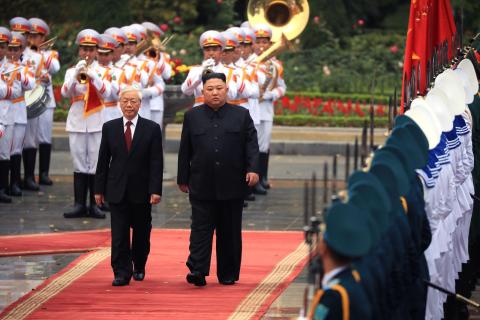South Korea has a national holiday on the first day of March to commemorate the start of the 1919 March First Movement. A century later, the legacy of the movement still resonates in both North and South Korea.
In South Korea, the constitution which had been established in 1919 by the provisional government became the basis for the government when it was formally established in 1948.
The March First Movement emerged as a result of foreign influence and domination and fuelled a desire for self-determination and self-governance. It led to the establishment of an enduring Korean independence movement. It also led to the formation of a provisional government that became the basis of South Korea’s current constitutional democracy.
Nationalism in Korea did not emerge suddenly.
Until the late 19th century, when it was “opened up” by Western powers, Korea was known as a “hermit kingdom” that limited its contact with foreign powers. It was as early as this “opening up” that nationalism flared against foreign influence.
Then, in the early 20th century, Japan annexed Korea. This period of Japanese occupation and subjugation saw an increase in Korean nationalist sentiment.
The March First Movement is noteworthy as it surpassed the Wilsonian ideas of that time. In 1919, self-determination was being offered to former colonies of the losing powers of the First World War. This did not include areas under Japanese occupation as Japan was a winning power. The movement demonstrated a willingness for Koreans to take to the streets against colonial power. The peace conference at the end of the war also was not the inspiration for the movement, it simply provided a catalyst for Koreans to publicise their grievances and aspirations.
Rather, the March First Movement was the culmination of long sought-after ideals.
In the 1910s, Japan sought to quash the Korean independence movement. The movement cost many patriotic Koreans their lives, and many more were injured or imprisoned as a result. The movement endured in spite of Japanese repression. It obtained popular support domestically and was able to foster international attention and support.
The growth of the movement led to an increase in armed resistance to Japan by Koreans in the 1920s and 1930s, particularly in northern China. One member of the Korean armed resistance, who joined forces with Chinese Communists, was a guerrilla fighter who would assume the name Kim Il-sung and later became the first leader of North Korea. The armed resistance to Japan by Koreans would expand further and eventually lead to the formation of the Korean Liberation Army.
Other nations that were under foreign domination in 1919 were also inspired by the March First Movement. Later that same year, the May Fourth movement broke out in China and tangible developments within the Indian independence movement emerged.
The Korean provisional government, established in April 1919, has had a lasting impact. The provisional government operated in exile for almost 30 years. This period of struggle was not in vain; support in the international community grew over the years to firmly support Korean independence. The international community helped to bring about Korean independence from Japan after the Second World War.
The negative result from this turn of events was, of course, the division of the Korean peninsula which coincided with the fraction of the wartime alliance and the emergence of the Cold War.
In North Korea, Kim Il-sung emerged as leader. The Kim family’s role in the resistance to Japan has been mythologised in North Korea by propaganda and the role of the independence movement and provisional government have been forgotten. Kim Il-sung is seen as the only major resistance fighter and this legitimises the rule of his family line to the present day.
In South Korea, the constitution which had been established in 1919 by the provisional government became the basis for the government when it was formally established in 1948. Legally speaking, the foundation for a Korean government had been functioning for quite some time and the positives of the South Korean system of government today can be traced back to the provisional government that was formed 100 years ago.
The seeds that were sown 100 years ago have resulted in the freedoms enjoyed in South Korea by over 50 million people today.

